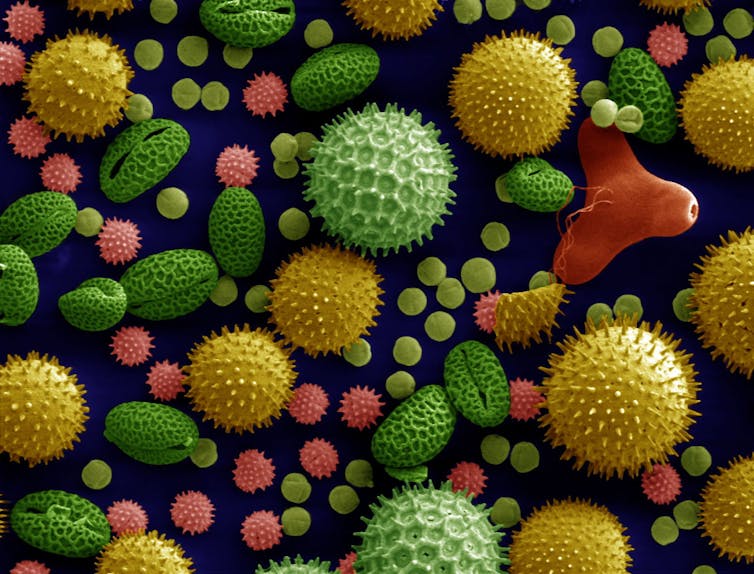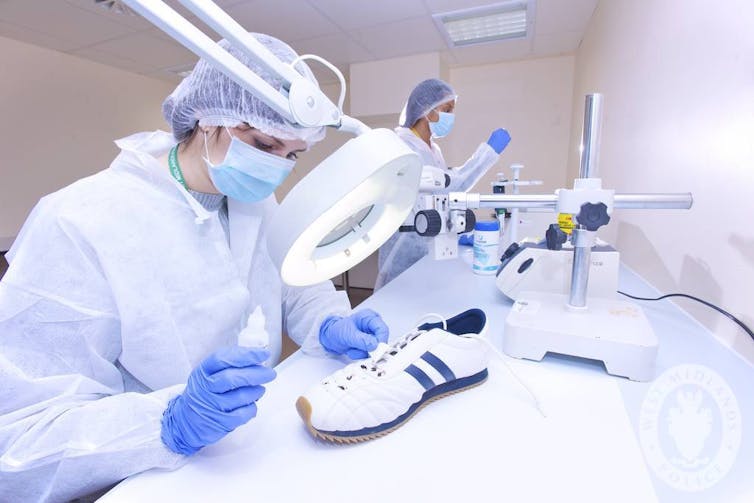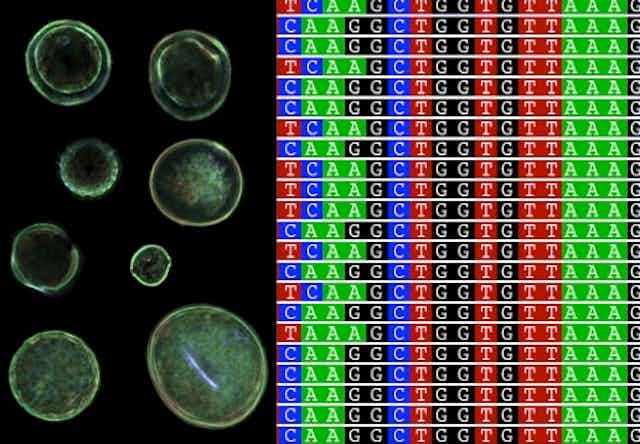Imagine you’re a detective working on a murder case. You have a body, but you believe it was moved from another location. Now what? There’s one unexpected tool you might use to follow up on this suspicion: forensic palynology. That’s the application of palynology – the study of pollen – to crime investigation.
But how does pollen have any bearing on forensics? While usually unseen, pollen is essentially ubiquitous in terrestrial habitats, and it is extremely tough. In fact, pollen is so durable that paleontologists can examine fossilized pollen grains in ancient sediments to see what plants grew during prehistoric times. And the “signature” of which pollen grains are present is specific to a particular place (because different plant species occur in different areas) and time (because different plant species flower at different times).
All of that makes pollen an ideal biomarker for linking people and objects to particular places and times, a central need in forensic investigations. Despite this potential utility, forensic palynology has been underutilized, because of its reliance on specialized experts to meticulously identify pollen visually under the microscope.
But researchers have recently developed a new technique for identifying pollen, using genetics. Since it makes identification much easier and faster for large numbers of pollen samples, we believe this development has the potential to transform forensic palynology, allowing us to harness the power of pollen to solve crimes.

Pollen as private eye
Forensic palynology has been particularly useful in cases where there is suspected movement of evidence, or where a crime has occurred in a location with distinct plant species. For example, following the Bosnian war, investigators uncovered mass graves where bodies had been moved from different locations. Pollen was one of the lines of evidence used to trace bodies to their original burial sites. In a case in New Zealand, a burglar was tracked to the scene of the crime when pollen grains on his clothing were matched to an uncommon plant species growing in front of the victim’s house.
There are many other types of cases where forensic palynology could be applied. Objects under examination in missing person cases could be traced to their origin. Analysts could tie individual criminals’ travel histories together based on finding a similar pollen species composition on seized evidence, possibly linking their crimes and providing direction for further investigation. Officials could determine illegal imports’ country of origin.
Traditionally, forensic palynology is done by examining pollen grains under a microscope and comparing them to known pollen morphology. This is a highly specialized skill, and there are few experts able to identify plant species based on the size, shape and color of the pollen grains. After all, researchers estimate almost 400,000 species of plants live on our planet today. There is currently only one person employed full-time as a forensic palynologist in the U.S.
Forensic palynology is further limited by the labor intensiveness of morphological identification. Frequently it’s impossible to determine the exact species present; identification is typically to a genus or family of plants – a group of species, in other words. This limits the technique’s utility, because while many plant species occur in a small geographic range, the genus or family in which they belong may cover a much broader area.
In a recently published article in Forensic Science International Genetics, we revealed how identifying pollen through DNA barcoding, on its own or with traditional palynology, could be a practical alternative.
Taking it to the DNA
DNA barcoding is a way to identify species via their species-specific genetic signatures. To do this for pollen, scientists sequence the DNA from a genetic region known to occur in all plants, but which varies from species to species.
There are two parts to the standardized sequence we use for plant DNA barcoding. One is a section of the large subunit of a gene called ribulose-1,5-bisphosphate carboxylase/oxygenase (rbcL for short). The other is a gene called maturase-K (matK). These genes are both essential for a plant to survive, and are thus present in all plants. Once an investigator sequences these gene regions from a sample, they can be compared to a database containing all the known DNA sequences of rbcL and matK to identify the species.
To DNA barcode pollen, the first step is to extract the DNA. Pollen grains produce the male reproductive cells (sperm) of the plant. Each pollen grain has a tough outer layer called the exine, made of a protein called sporopollenin. We need to break the exine in order to release the DNA that’s protected inside. We do this by putting the pollen grains in a tube filled with small silica beads and shaking vigorously for several minutes. Once the cells release their DNA, it can be purified and then sequenced.
High-throughput DNA sequencing is a methodological advance that has made pollen DNA barcoding feasible. This new method allows researchers to sequence multiple pieces of DNA at the same time, without separating them first. It’s a key innovation because forensic pollen samples typically contain a mixture of species. Without high-throughput sequencing, these species would first need to be painstakingly separated – and then we’d be back to the same efficiency problems of traditional morphological analysis. With high-throughput sequencing, the whole mixture of pollen grains can be ground up in one sample, the DNA isolated and sequenced, and matched to a database. This technique is known as DNA metabarcoding.

Ready to report for duty?
Although pollen DNA barcoding has not yet been applied to forensic palynology, similar techniques have been used to quality test honey, determining the plant species on which bees have been foraging. Pollen DNA barcoding has also contributed to air quality monitoring, when it’s useful to know what allergens are present in the environment.
Optimizing these methods for forensics may require some small modifications, such as dealing with very few pollen grains in a sample. Ideally a standardized method should be developed for forensics, to enable comparisons between different cases, studied by different scientists. It will also be necessary to expand the reference databases, to include more species that might be of interest to forensics specialists.
But while there are still a few hurdles to overcome, eventually pollen DNA barcoding could become a common and scientifically rigorous technique in law enforcement and national security.

